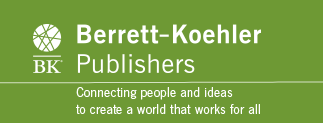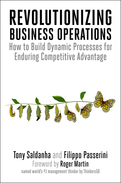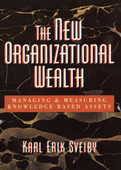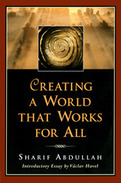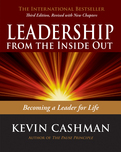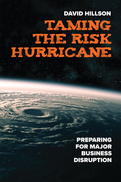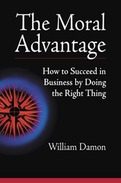If you have a great product, but don't have the operations in place to efficiently and effectively support it-production, manufacturing, sales, finance, human resources, etc.-you won't succeed. Product innovation is seen as flashier and so gets far more attention, but you can create an enduring competitive advantage by revolutionizing business operations.
The problem is most attempts to improve business operations are reactive, sporadic, and siloed. Tony Saldanha and Filippo Passerini's Dynamic Process Transformation model provides a living model for constant, ongoing process evolution and optimization.
The authors focus on maximizing three drivers of change. First, open market rules-each business process must be run as a separate business, instead of via monolithic mandates coming down from on high. Second, there must be unified accountability- outcomes must be clear and consistent across the company, instead of being siloed within departments. And third, there needs to be a dynamic operating engine, a methodology to convert the constantly changing business process goals into tactical day-to-day employee actions.
With numerous examples from leading companies, this book shows how to proactively keep business processes across the company from becoming obsolete and take advantage of a neglected key to success.
Shares in Microsoft, the world's largest computer software firm, changed hands at an average price of $70 during 1995, at a time when their "book value" or "equity" was just $7. In other words, for every $1 of tangible value, the market saw $9 of additional value, for which there was no corresponding record in Microsoft's balance sheet. This extra $9 in the value of Microsoft shares represents a major trend. More and more, companies are deriving value from their intangible assets. These assets include their employee's creative ideas, their customers' loyalty, their ability to attract and keep prestigious accounts, their innovative products and services, their popular brand names, and their reputation.
Knowledge-based organizations with intangible assets, such as accounting and legal firms, management consultants, advertising agencies, medical clinics and hospitals, software and engineering companies, and the art and entertainment industry make up the fastest growing business sector. Yet few of these companies achieve their potential performance and profitability because they do not know how to exploit their intangible assets. They measure performance only in terms of money, ignoring less tangible but vital assets such as the ability to capture high profile customers or the creativity to keep the company on the cutting edge with innovative products or services.
The New Organizational Wealth shows how some of the fastest-growing, most profitable companies are discovering that potentially limitless revenues can flow from their firm's intangible assets-the ability of employees, customers, and even suppliers to create new concepts, models, products, and services. Among the book's many examples is Netscape Communications. This successful company demonstrates the profitable results of fostering long-term customer relationships and the effectiveness of investing in employee competence to maintain a rich pool of talent.
The New Organizational Wealth outlines the conceptual framework for changing business strategies to focus on intangible assets. Using its guidelines, managers can learn how to identify the indicators for their company's intangible assets-their employee's talents and strengths, their customers' support and interest, and their supplier's reliability and ingenuity. Specific chapters detail how to effectively use and measure these "tacit" assets, as well as how to monitor them for financial success. Helpful case studies of Scandanavian companies such as WM-data-s, Skandia AFS, and Celemi, which have developed systems for measuring intangible assets and publicly reporting the results, provide models managers can use in leading their companies to increased profitability and long-term organizational success.
- The first book on managing and measuring intangible assets
- Shows how to tap customer and employee knowledge to build a more successful organization
- Provides tools for measuring such intangible assets as competent and creative employees, patents, brand names, or company reputation
- Written by an experienced manager who played a key role in developing the "Scandinavian Movement" of management
But there is hope. Abdullah shows how we can change our world by changing our consciousness. We can actually put an end these complex problems if we reject exclusivity in favor of inclusivity. We must turn from a mentality that disconnects us and instead embrace the goals of restoring balance to the earth and building community with all other people. In Creating a World That Works for All, Abdullah provides a practical blueprint for that change.
Abdullah makes it clear that there are no bad guys to blame: we are all equally responsible for the current state of our world. We each have created it, and we each have equal power to change it. Abdullah offers three criteria for creating a world that works for all:
1. The Criteria of Enoughness: Everyone has enough, even though not everyone shares resources equally
2. The Criteria of Exchangeability: Trading places would be okay
3. The Criteria of Common Benefit: The system is designed and intended to benefit all
In order to meet these criteria, Abdullah shows us how to let go of old theories and ideas, so we can clearly see our current problems and possible solutions. And he shows us how to create new stories that explain and define the new behaviors that make cultural changes possible.
- Shows how we can create a world that works for all by rejecting the practice of exclusivity in favor of inclusivity
- Uses numerous insightful stories to illustrate how and why things don't work and how they can be made to work if we are willing to change our thinking and our society
This classic bestseller by Kevin Cashman pioneered a holistic approach to leadership development: grow the whole person to grow the whole leader. The third edition turns leadership development inside out for a new generation of authentic, purpose-inspired leaders.
This book was the first to reveal and build on a foundational insight: we lead by virtue of who we are. Cashman's trademark whole-person approach is essential to success in today's talent-starved marketplace and provides a measurable return on investment. Framed in seven simple yet profound personal mastery areas, this book serves as an integrated coaching experience that helps leaders understand how to harness their authentic, value-creating influence and elevate their impact as individuals, in teams, and in organizations.
The third edition contains updated content in the first three chapters-Personal Mastery, Purpose Mastery, and Interpersonal Mastery (the most foundational chapters in the book)-and includes a new chapter, Story Mastery: Leading with Inspiration. This chapter deepens comprehension of authenticity, provides a more significant sense of meaning and purpose, and inspires more profound interpersonal connection. For everyone from CEOs to emerging leaders, this long-awaited third edition advances the art and science of leadership, which makes the book even more relevant today than when it was first published.
Risk management has become a standard part of the strategic tool kit, providing senior leaders with a forward-looking radar to scan the future and give early warnings of approaching threats and opportunities. However, even best-in-class organizations can falter in the face of extreme risk exposure. Special circumstances demand special responses, and extreme risk exposure needs very careful handling. Routine risk management approaches will fall short, but businesses that demonstrate a high degree of flexibility and resilience will have the competitive advantage and the ability to thrive where others fail.
The causes and consequences of meteorological hurricanes have parallels in the way uncontrolled risk exposure can develop in organizations. Both are caused largely by predictable factors, but both are characterized by sustained uncertainty and severe impact once they develop. If we can learn to predict a risk hurricane, prepare for it effectively, and survive its effects, then our organizations will be well placed to address the challenge of extreme risk exposure, if and when we are unfortunate enough to face it.
2004
- Examines the many ways that adhering to a personal moral code helps people succeed in business by conferring a "moral advantage"
- Tells compelling stories of real-life business leaders who have achieved great success without compromising-in fact because of-their moral convictions
- Written by the acknowledged leading scholar on moral psychology in this country and perhaps the world today
